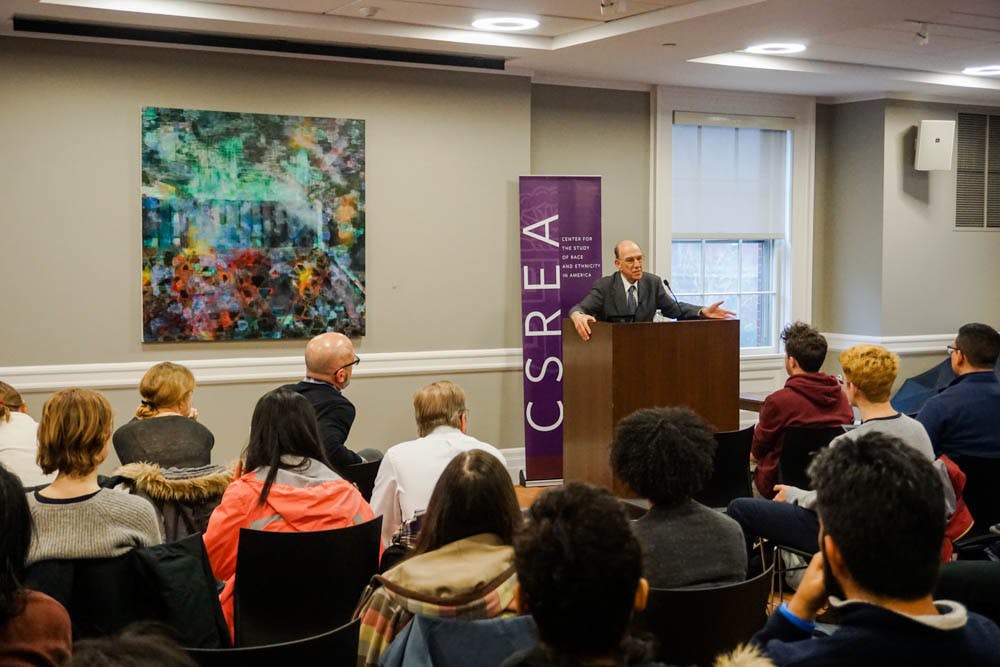Richard Rothstein, a Distinguished Fellow at the Economic Policy Institute, discussed the idea that federal, state and local government policies have segregated metropolitan areas into racially homogeneous neighborhoods and potential government remedies during a talk at the University Thursday.
Sponsored by the Center for the Study of Race and Ethnicity in America, the event was part of a larger series called “Segregated: Structural Racism and the Shaping of American Cities.” Rothstein centered the lecture around his new book, “The Color of Law: A Forgotten History of How Our Government Segregated America.”
Rothstein spoke about his perspective on the ramifications of the Housing Act of 1949, passed by Congress after World War II, which led to segregated residential communities. During the war, the Public Works Department built integrated public housing for middle-class families within walking distance of factories. But as veterans returned from the conflict, the nation faced a housing shortage, requiring Congress to take action, Rothstein said.
The 1949 legislation facilitated the separate construction of low-income housing for black and white communities. White homeowners eventually found middle-class jobs and “fled to the suburbs,” while black homeowners remained in public housing, which fell into a state of disrepair, Rothstein said. “People couldn’t understand why white public housing units were vacant, yet black public housing had long waiting lists,” he added.
As the value of suburban homes rose, black working-class individuals could rarely afford to move to the suburbs, Rothstein said. The few who could were often denied home ownership by the white developers. Ultimately, government practices reinforced this “de facto segregation” by building affordable housing in areas already occupied by black communities with low property values, he added.
Furthermore, “thousands of instances of mob violence, protected by police, (drove) African Americans out of white (suburban) neighborhoods” such as Levittown, PA, Rothstein said.
“It’s a lot harder to (end) segregation in neighborhoods than segregation on water fountains” through legal measures, Rothstein said. Residential segregation occurs because of private individuals, homeowners and citizens who feel more comfortable living near others with a similar racial and socioeconomic background, he added.
In order to resolve segregation, the government should “subsidize African Americans to move into integrated neighborhoods,” Rothstein said. In addition, Rothstein warned against the implementation of “temporary reparations” in place of “permanent remedies.”
Outside of government action, universities should “give a bonus to individuals applying from integrated neighborhoods,” which would “benefit both (black communities) and (white communities) and would incentivize people to move” to integrated areas, he added.
Rothstein first became interested in government segregation after studying the efficacy of American education policy in the 1990s, which focused on reducing the achievement gap between black and white Americans through “accountability policies.” These policies did not work and he “began to worry about the concentration of disadvantages in school” across racial lines, he said. Schools have become “more segregated than ever before” as urban residential neighborhoods became segregated, he added.
By attending the lecture, Annelise Ernst ’21 said she learned that “it’s not just individual prejudice that resulted in segregation in terms of housing. … A lot of it is rooted in deliberate government action.”
Rothstein’s proposal to offer admission incentives for people living in integrated neighborhoods was particularly interesting, she said. Incentivizing people to move into less homogeneous areas was “something that I hadn’t thought about before,” she added.
Frances Imarhia’22 said that Rothstein made her “think about solutions to these housing and discrimination (problems) and (how) it affects us in modern times. Typically we say racism and segregation just exist, but the fact that he offered solutions was good.”
“Segregation today has so many consequences for the problems we face today,” Rothstein said. It fosters an environment in which citizens “have no ability to empathize with one another.”





